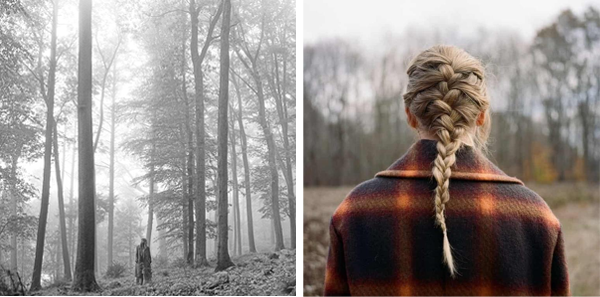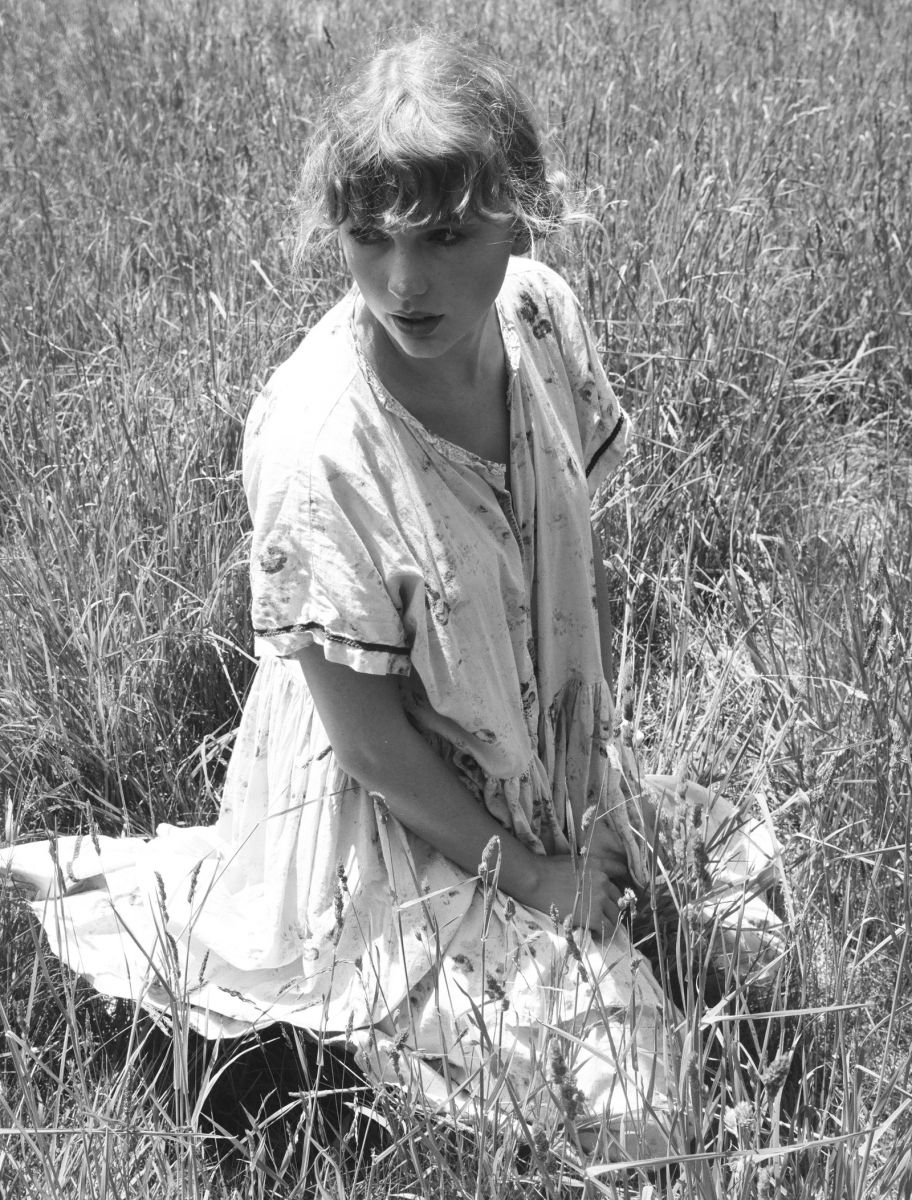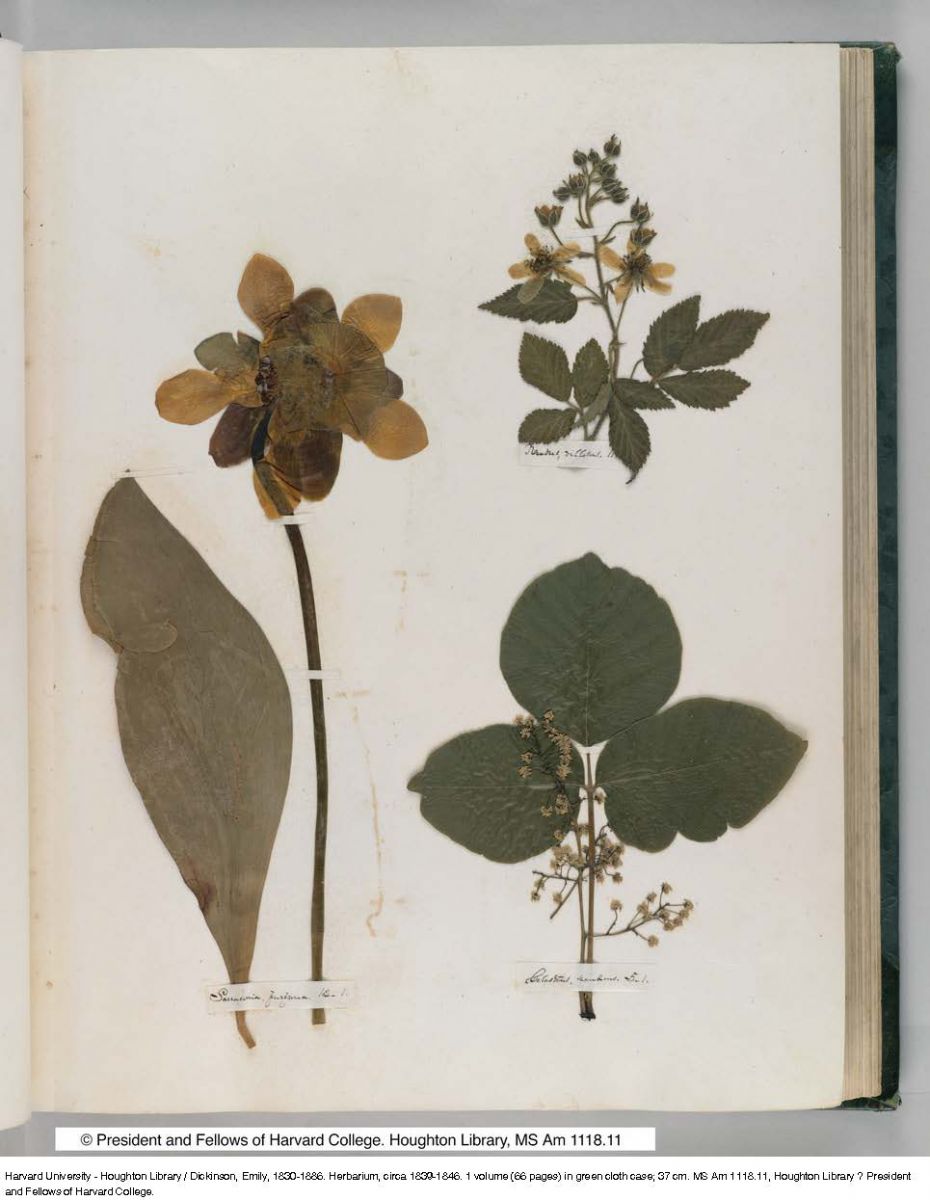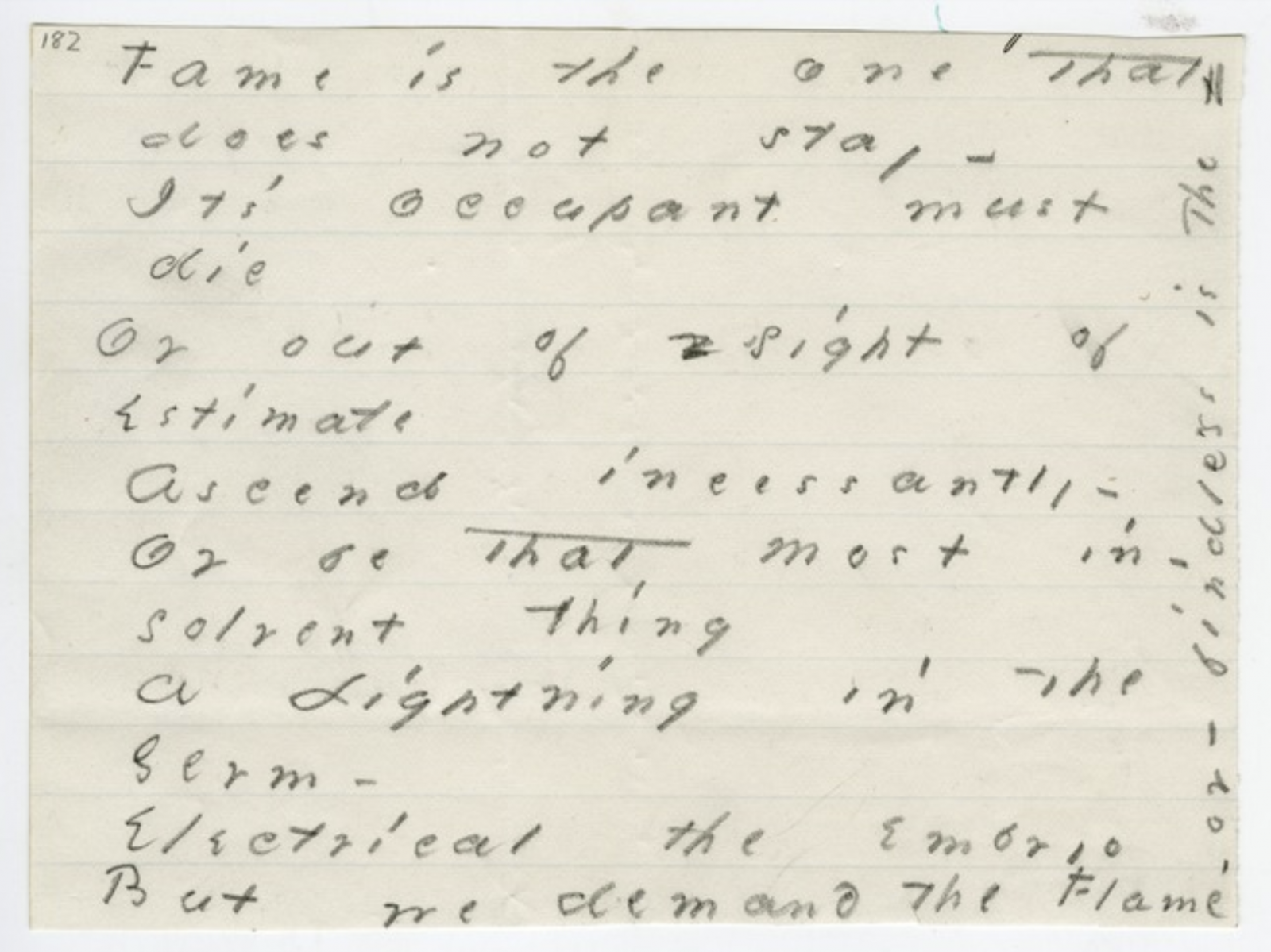- The Ghosts of Emily Dickinson: Hauntings in Popular Culture
- Introduction: Which Dickinson? by Jeannette Schollaert
- Specters on Screen
- Big Reputations: Celebrity and Temporal Duration in/of Dickinson Lyrics by Elizabeth Dinneny
- Ghosts in the Algorithm: The Dickinsons on TikTok by Elizabeth Dinneny
- "Dickinson-core" by Jeannette Schollaert
- Contributors
- Works Cited
Big Reputations: Celebrity and Temporal Duration in/of Dickinson Lyrics by Elizabeth Dinneny
Big reputation, big reputation
Ooh, you and me would be a big conversation
Taylor Swift, “End Game”
On December 10, 2020, Emily Dickinson’s 190th birthday, singer-songwriter-superstar Taylor Swift announced the surprise release of her ninth studio album, evermore. The release was a shock, as Swift had released her first surprise album, folklore, a short five months previous. Swift called folklore “a product of isolation,” made together with a small group of musicians during the first several months of the COVID-19 pandemic. Its aesthetic, which continues into evermore, evokes the newly-popular “cottagecore” trend.[1] Swift spoke of her inspiration for the album’s cover photograph with Entertainment Weekly: “I had this idea…that it would be this girl sleepwalking through the forest in a nightgown in 1830” (Suskind). In folklore’s black-and-white cover image, Swift is the sleepwalking girl wearing a custom Stella McCartney jacket (Grindell) in the year of Emily Dickinson’s birth. In evermore’s full-color image, Swift has emerged from the woods and looks back toward it—notably diverging from the look of her eight previous album covers, in which her face appears up close, front and center. Perhaps evermore contains Swift’s least autobiographical lyrics, as some critics have suggested (Petrusich), thus opening up even more possibilities for fictional and biographical inspiration.[2] But we might take a more critical approach. Using the term “autobiographical” risks feigning individual influence and a singular archive. Taylor Swift is certainly known for writing specific autobiographical elements into her lyrics, but we need not abandon autobiography in the face of evermore’s expansive archive. Rather, we should ask: how do these archives mediate the autobiographic? Where do we find Swift and Dickinson, together, in “these imaginary/not imaginary tales” (@taylorswift13)?

Fig. 1. Left: folklore's black-and-white cover image, in which Swift stands small among looming trees in a forest. Right: evermore's warm-toned cover image. Swift's back is to us, so that the camera's focus is on her heavy coat and braided blonde hair. Photographs by Beth Garrabrant.
The two so-called “sister record[s]” (@taylorswift13) contain stories from myriad archives, including allusions to Romanticism and Swift’s own life. While folklore, with its mentions of Wordsworth and the Lake District, appears invested in the figures and motifs of British Romanticism (Ellis), evermore seems most influenced by one writer in particular: Emily Dickinson. As a result of popular culture’s recent increased interest in Dickinson, Taylor Swift fans knew enough about the poet to begin speculating about Dickinson’s presence in evermore almost immediately. Most conspicuous is the album’s title (and concluding) track, “evermore,” which meditates on a failed relationship whose “pain would be for / evermore” (Swift et al.). The song recalls the final line of a letter-poem written by Emily Dickinson to Susan Huntington Dickinson. The poem ends:
I spilt the dew –
But took the morn, –
I chose this single star
From out the wilde night’s numbers –
Sue _ forevermore!
(OMC 76)
The song and the poem differ significantly in tone, as “evermore” recounts the miscommunications of a past relationship, and Dickinson’s letter expresses an endless devotion to her sister-in-law and lover, Susan Huntington Dickinson. However, both texts share an investment in letter-writing for the articulation and navigation of an intimate relationship. In “evermore,” one narrator is found “writing letters / addressed to the fire,” indicating a failure in communication and the eventual demise of the relationship. Dickinson’s letter-poem to Susan, in addition to celebrating an enduring relationship, demonstrates the value of the letter (and lyric) as a form of intimate expression. Far from being “addressed to the fire,” Emily Dickinson’s letter-poems made their way into Susan Huntington Dickinson’s hands, “a hedge away,” (OMC 76) for decades.
The duet’s speakers also use metaphors of shipwreck to recall their relationship’s collapse. For example, Swift sings, “Hey December / Guess I’m feeling unmoored,” and, later, Bon Iver sings, “I’m on the waves, out being tossed / Is there a line that I could just go cross?” These lines are only a few of evermore’s broad nautical and temporal vocabulary; the album opens with the line, “I’m like the water / when your ship rolled in that night” (Dessner and Swift). In “long story short,” whose joyful tone matches that of Dickinson’s aforementioned letter-poem, Swift sings, “my waves meet your shore / ever and evermore” (Dessner and Swift). The speaker of “long story short” hopes to moor, for evermore, in the song’s addressee. Here, we turn to Emily Dickinson again; in her poem that begins “Wild nights – Wild nights!”, the speaker is “Done with the Compass - / Done with the Chart!” and wishes to “moor” in the poem’s addressee:
Wild nights - Wild nights!
Were I with thee
Wild nights should b
Our luxury!
Futile - the winds -
To a Heart in port -
Done with the Compass -
Done with the Chart!
Rowing in Eden -
Ah - the Sea!
Might I but moor - tonight -
In thee!
(Fr269A)
Both Dickinson and Swift invoke the shore as the site of a relationship’s convergence.[3] The speakers escape turbulent waters by finding stability in another person, on the shore, repeatedly. The comparison is complicated by the conditional temporality of “wild nights,” and the poem’s queer interpretations and theorizations cannot go unstated (Smith, Brinck-Johnsen), By reading Dickinson and Swift together, we see how both lyricists consider temporality and the potential of a “forevermore” in multiple forms, including that of an intimate romantic relationship.

Fig. 2. A black-and-white film photograph of Taylor Swift sitting in a field of tall grass. She is wearing a short-sleeved white cotton dress, also known as the nap dress of recent cottagecore fame, and she looks into the distance, pensive. Photograph by Beth Garrabrant.
The folklore/evermore “era,” to use a Swiftian term (Braca), embraces a cottagecore aesthetic, easily identifiable in the album’s lyrics, acoustic instrumentation, woodsy cover art, and promotional images. The cottagecore aesthetic combines the fable of Dickinson the genius recluse with Dickinson the R/romantic, complementing the conditions and themes of both Swift albums. Swift’s most cottagecore song, “ivy,” has received significant attention from a number of Dickinson fans, who believe the song is inspired by Emily and Susan’s relationship. The album’s tenth track, which has been described as “a folky, convoluted song,” (Pareles) involves a married speaker who falls in love with someone else. The speaker describes the three of them (speaker, lover, husband) in a room, possibly at a party:
I wish to know
The fatal flaw that makes you long to be
Magnificently cursed
He’s in the room
Your opal eyes are all I wish to see
He wants what’s only yours (Swift, Antonoff, Dessner)
Neither the speaker nor the “magnificently cursed” lover are assigned pronouns, leaving plenty of room for queer interpretations of this song about a forbidden, passionate relationship, which the speaker calls “the goddamn fight of my life” (Swift et al). In their own queer readings, Dickinson fans have made fan videos of “EmiSue” scenes set to the song, whose lyrics can be cleanly mapped onto their relationship.[4] In addition to biographical consistencies, the characters of “ivy” employ metaphors of death and augmented temporality that resonate affectively with much of Dickinson’s poetry. The song begins in a graveyard, or at least a metaphorical one: “How’s one to know? / I’d meet you where the spirit meets the bones / In a faith-forgotten land” (Swift et al.).[5] The graveyard functions as a safe place for the two to get together, removed from the public eye and from the expectations of “the living.” Among the dead, the illicit affair of “ivy” is allowed to flourish, as the speaker sings, “my house of stone / your ivy grows, / and now I’m covered in you” (Swift et al).

Fig. 3. One page from Emily Dickinson’s herbarium. This image features four specimens, including Toxicodendron radicans, or, poison ivy. Dickinson, Emily, 1830-1886. Herbarium, circa 1839-1846. 1 volume (66 pages) in green cloth case; 37 cm. MS Am 1118.11, seq. 9, Houghton Library © President and Fellows of Harvard College.
Using botanical imagery, the speaker describes an organic infiltration of the “magnificently cursed” lover, or unruly ivy, on the married, heterosexual home. Further, the speaker sings, “the old widow goes to the stone every day / But I don’t, I just sit here and wait / Grieving for the living” (Swift et al.). With its affinity for the dead, this secret relationship thus appears unconcerned with linear time and social realities. The speaker grieves for their living relationship, which has yet to end, then happily escapes to “your dreamland” (Swift et al.). Emily Dickinson wrote many poems about death, graves,[6] and privacy.[7] Although we push back on the idea of Dickinson as recluse, Dickinson’s life-long romantic relationship with Susan was certainly enjoyed in private. Similarly, the contentedly secret relationship of “ivy” defies heterosexual expectations of public interpellation. Rather than become legible to friends (as the three seem to travel in similar circles) and family, the two, “a goddamn blaze in the dark,” endure.
Swift is known for leaving self-referential clues throughout her corpus, so it’s worth noting that evermore might not contain her first nod to Dickinson. repuation, Swift’s album most explicitly about her struggles with fame and social media, ends with the album’s most romantic and sole piano track, “New Year’s Day.” In the song, the speaker sings to another “you,” the morning after a New Year’s Eve party. A similar reflection on the duration of romantic relationships, Swift implores them, “Don’t read the last page,” and tells of what remains following the celebration:
There’s glitter on the floor
After the party
Girls carrying their shoes
Down in the lobby
Candle wax and Polaroids
On the hardwood floor
…you and me, forevermore
Here, again, Swift uses “forevermore” to describe hope for the endurance of an intimate relationship, just as she uses the phrase in “long story short” and “evermore.” “New Year’s Day” emerges as the album’s most cathartic moment. After numerous tracks about Swift’s most arduous years in the spotlight, “New Year’s Day” finishes the album as a song solely about her intentionally private relationship with current partner Joe Alwyn (Stanton). In addition to repeating the desire for a forevermore relationship, the more transparent “long story short” explicitly references these same reputation moments from Swift’s life and discography, offering a quick account of Swift’s romantic troubles and a longer reflection on Swift’s falling out of public favor. As one critic writes, “conceptually, it [“long story short”] retreads reputation ground,” (Ahlgrim and Larocca) featuring clear autobiographic elements and expressing a frustration with the attention and misogynistic demonization that accompanies fame: “And I fell from the pedestal / Right down the rabbit hole / Long story short, it was a bad time” (Dessner and Swift).
Rather than continue to pick apart evermore’s lyrics for possible references to Dickinson’s poetry (as there are plenty more[8]), we should turn to overlapping and interacting thematics and conditions of production. In social media posts and interviews, Taylor Swift emphasized the conditions of the sister albums’ production; that is, she underlined the fact that both were created “in isolation,” in relatively quick succession, and secretly amid a small circle of collaborators (@taylorswift13). Swift told Entertainment Weekly: “I wasn’t making these things with any purpose in mind. And so it was almost like having it just be mine was this really sweet, nice, pure part of the world as everything else in the world was burning and crashing and feeling this sickness and sadness. I almost didn’t process it as an album. This was just my daydream space” (Suskind). Emily Dickinson did not write her poetry during a global pandemic, but she did often write in a kind of isolation, disseminating her poetry among close friends and family with less regard for the expectations of print publishing (Smith). Isolation here means, of course, not the sequestration of the individual artist, but the cultivation of a small, trusted collective through which the artist’s work is circulated and workshopped. Their works-of-isolation now commercial and widely distributed art objects, both Dickinson and Swift have grown into infamous public figures, onto whom their readers, listeners, and critics project personalities, intentions, and rumors.
If Taylor Swift is a celebrity, then Emily Dickinson’s ghost is one as well. Dickinson’s ghost is the figure of Dickinson in and constructed by popular culture, shifting and disappearing into words and works like those discussed in this exhibition. By ghost, I mean the specter cast by fame, a formulation that Dickinson used in her own writing, “at a time when ghosts were ubiquitous within literary tourism and when a visit to the writer’s home or meeting with a celebrity was akin to a spiritual encounter” (Finnerty 34). Several speakers found in Dickinson’s poetry revere the dead like a fan might revere their favorite celebrity, visiting the star's birth place, home, and grave (Finnerty 45). The dead celebrity thus becomes a ghost, the product of public reverence or, to use a word from Swift’s lyrical vocabulary, the product of reputation. Though she did hope to publish, Dickinson ruminated on fame across many poems and letters, expressing a desire for it but also often a deep concern about the restrictions of print publishing (Reynolds, “I’m Nobody…”, Finnerty) and the potential misconstruing of the person by celebrity. Commercial publishing opens up the potential for a ghost, made immortal but out of the artist’s control, defined by critics, scholars, and other readers. In her lifetime, Dickinson’s handmade fascicles were self-published; she produced copies of poems, bound them together, and distributed them herself, but the fascicles on their own do not conjure the specters of Dickinson that we encounter today. Martin Greenup reads the inaccessible dead of Dickinson’s “Safe in their Alabaster chambers” as her own poems, the chambers her fascicles if she did not publish commercially (356). Without publishing, Dickinson and her poems would most likely not endure the unforgiving abyss of time, and her fascicles would remain untouched by generations of readers, safe but dead, we might say, “forevermore.”
Perhaps confirming her most serious anxieties and optimisms, Dickinson haunts writers and popular culture more than a hundred years after her death. Specters of her reputation emerge across these essays, making this exhibition a kind of graveyard of multiple Emily Dickinsons, none of them “true,” many of them contradictory. In Taylor Swift’s introduction to reputation, she writes that “gossip blogs will scour the lyrics” to explain the meaning of each song, connecting them to Swift’s ex-boyfriends and paparazzi photos. She concludes with a critique of celebrity and identity itself: “We think we know someone, but the truth is that we only know the version of them they have chosen to show us. There will be no further explanation. There will just be reputation” (Swift). Much of the same can be said about Emily Dickinson, whose poetry and larger archive has been scoured for evidence of male lovers, proof of her supposed isolation, and combed through for final, stable versions of her poems.[9] Despite these attempts at discerning the facts, there will only ever be Dickinson’s reputation, as constructed by her readers. We might respond to Swift’s assertion by asking what we do, then, with the archive. How should we interpret the archive of the living (or dead) person? Let us turn, one last time, to Dickinson’s own lyrics:
Fame is the one that does not stay —
It’s occupant must die
Or out of sight of estimate
Ascend incessantly —
Or be that most insolvent thing
A Lightning in the Germ —
Electrical the embryo
But we demand the Flame

Fig. 4. Dickinson’s handwritten poem, beginning “Fame is the one that does not stay,” in pencil on cream-colored lined paper. The final line trails the bottom edge of the paper and follows up the right side, as if Dickinson ran out of space before finishing the line. “Fame is the one that does not stay.” Amherst College Digital Collections.
The speaker is uninterested in fame, which remains at the mercy of cultural interest and the status of its dead occupant. Instead, the speaker urges us to “demand the Flame.” What Flame of Dickinson’s must we demand? Perhaps the Flame is another kind of ghost, but one that is much more difficult to make out. The Flame might be the stubborn specter that endures in spite of attempts at erasure or adjustment. Despite Mabel Loomis Todd, Higginson, and others’ efforts to shape Dickinson’s legacy into one more marketable, more heterosexual, and more conservative, there remains a stubborn ghost, a “goddamn blaze in the dark,” (Swift et al) deep in the archive. She appears only in flickers, but she endures, just as we must demand, over and over, to see her.
Swift’s evermore is only the most recent iteration of Dickinson in music; numerous artists and songwriters have been inspired by the poet. For a selection of these, explore the exhibition's curated Spotify playlist.
Notes
[1] Cottagecore and Dickinson are discussed thoroughly by Jeannette Schollaert in “Dickinson-core.”
[2] folklore’s “the last great american dynasty,” for instance, explicitly draws from the archive of Rebekah Harkness, the previous owner of Swift’s Rhode Island residence. The lyrics chronicle Harkness’ extravagant life in the home and eventually draw comparisons between her reputation and Swift’s. See Walsh, “The True Story Behind Taylor Swift’s ‘The Last Great American Dynasty.’”
[3] In addition to Jack Antonoff and Aaron Dessner, Swift’s co-writers on the tracks.
[4] silently-dreaming. “Emily & sue || ivy (dickinson). YouTube, uploaded 19 December 2020, https://www.youtube.com/watch?v=-Ejyl2MnU0U.; @andsadprose. “your ivy grows.” 23 February 2021, https://vm.tiktok.com/ZMeA34Yx4/, and others.
[5] Swift has deployed the space of the graveyard elsewhere, in her music video for reputation single “Look What You Made Me Do,” which opens in a graveyard featuring two Swift headstones, including one that marks her songwriting pseudonym Nils Sjoberg. The camera zooms into one gravestone, which reads, “HERE LIES TAYLOR SWIFT’S REPUTATION.” This graveyard contains Swift’s various forms, as constructed by critics and social media users. In the video, Swift later appears as over a dozen different exaggerated and contradictory versions of herself. Like the versions of Dickinson in this exhibition, none of these Swifts are true.
[6] “Because I could not stop for death” (Fr479),“I died for beauty, but was scarce” (Fr448), “We do not play on Graves” (Fr599) “It was a Grave, yet bore no Stone” (Fr852).
[7] See Páraic Finnerty, “‘If fame belonged to me, I could not escape her’: Dickinson and the Poetics of Celebrity.”
[8] See Hollie Richardson, “Why Taylor Swift fans are convinced Emily Dickinson inspired her new album,” and Shaffer and Spanos, “‘Goodbye Earl’ to Emily Dickinson: A Rundown of Taylor Swift’s Influences on ‘Evermore.’”
[9] Martha Nell Smith writes about the issue of autobiographical interpretation of Dickinson’s works in Rowing in Eden.



